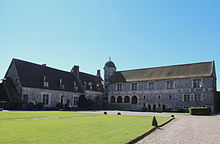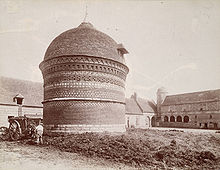Jehan Ango
Jehan Ango or Jean Ango geb. Jehan Angot (* 1480 or 1481 ; † 1551 ), was an important Norman shipowner and businessman from Dieppe . He expanded the merchant fleet built up towards the end of the Hundred Years War of his family, which originally came from Rouen , and married into the important Diepper shipowner family of the Guilbert. For a time, Jehan Ango Grenetier , Contrôleur du magasin de sel , Capitaine du chateau de Ville of Dieppe and was appointed Viscount de Dieppe by King Francis I (France) .


Ango traded with Flanders and England, but showed early interest in more distant destinations and developed an activity that is unparalleled in Normandy. He maintained good relations with the Florentine bankers and financiers in the city, who often helped him finance his ventures.
Ango equipped Giovanni da Verrazzano's second research expedition and financed the travels of Binot Paulmier de Gonneville to the New World. In addition, he supplied the first pirate companies against the Portuguese in Brazil with equipment. After the Portuguese had captured one of his ships, the "Marie", he received his first Lettre de Marque ( letter of misery ) from King Francis I as a replacement for this loss. In 1543, he received another letter of misery for the loss of the "Michelle" compensated the Portuguese off the coast of Brazil. As a result, he was entitled to hijack Portuguese ships as compensation for the damage suffered.
As a result of this increased pirate activity, King John III showed himself. of Portugal in 1534 concerned about the increased appearance of French off the Brazilian coast. Although this action was in line with Francis I's foreign policy (who at this time publicly attacked the Treaty of Tordesillas ), his direct support could be found - apart from the royal letter of invasion and a meeting between the king and Ango in Dieppe in 1533/1535 - do not prove.

In 1531 Ango equipped galleons for an attack on Havana , in 1537 Spanish spies reported that 37 ships were leaving with the aim of raiding Spanish ports in America. The planning, financing and execution of these undertakings were entirely in the hands of Angos, who had meanwhile made a fortune with trips to Guinea , Newfoundland and Brazil and who most recently fully controlled the shipping traffic and capital market in Dieppe. Ango remained deeply connected to this city, held several positions in the city administration in the course of his life ( Grenetier , Contrôleur du magasin de sel , Capitaine du chateau de ville ) and was even promoted to Viscount de Dieppe . He had two castles built, the Manoir d'Ango in Varengeville-sur-Mer and a city palace built in the Florentine style, and as a patron he also promoted the city's cultural life.
Towards the end of his career, his financial situation deteriorated noticeably. A former business partner was litigating him and the French king demanded the repayment of 14,600 livres d'or . This demand from King Henry II (France) is also particularly noteworthy because Ango had, among other things, contributed to the ransom that Francis I had to pay to the emperor after his capture in Pavia. After the collapse of his illustrious career, Ango died in 1551.
literature
- Jean Michel Barrault: Le Sacre et La Pensée: 1529, de Dieppe à Sumatra; les capitaines-poètes de Jean Ango ouvrent la route des Indes fabuleuses . Seghers, Paris 1989, ISBN 2-232-10167-3 (French).
- Jean Ango . In: Arlette Jouanna (ed.): La France de la Renaissance: histoire et dictionnaire . Laffont, Paris 2001, ISBN 978-2-221-07426-8 , pp. 587-588 (French).
- Jean-Pierre Moreau: Une histoire des pirates: Des mers du Sud à Hollywood . Editions du Seuil, Paris 2007, ISBN 978-2-7578-0484-1 (French).
- Eugen Pfister: The other side of the coin - French steps into the "New World" 1540-1598 in: Alexander Marboe, Andreas Obenaus (ed.) Seafaring and the early expansion . Mandelbaum Verlag, Vienna 2009, ISBN 978-3-85476-299-7
Individual evidence
- ↑ Ango (without T) is the Italianized form of the common Norman surname Angot, itself of Old Norse origin Asgautr , as a first name.
- ↑ Urs Bitterli: The discovery of America: From Columbus to Alexander von Humboldt . Beck, Munich 1999, ISBN 978-3-406-42122-8 , pp. 118 .
- ↑ a b c Jean Ango . In: Arlette Jouanna (ed.): La France de la Renaissance: histoire et dictionnaire . Laffont, Paris 2001, ISBN 978-2-221-07426-8 , pp. 587-588 (French).
- ↑ a b c Jean-Pierre Moreau: Une histoire des pirates: Des mers du Sud à Hollywood . Editions du Seuil, Paris 2007, ISBN 978-2-7578-0484-1 , pp. 248-250 (French).
| personal data | |
|---|---|
| SURNAME | Ango, Jehan |
| ALTERNATIVE NAMES | Ango, Jean |
| BRIEF DESCRIPTION | French shipowner |
| DATE OF BIRTH | 1480 or 1481 |
| DATE OF DEATH | 1551 |